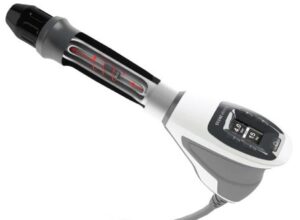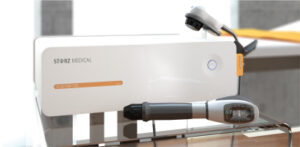Introduction to Shockwave Therapy ESWT For Chiropractic Treatments
Extracorporeal shock-wave therapy (ESWT), which can be divided into radial shock-wave therapy (RaSWT) and focused shock-wave therapy (FoSWT), has been widely used in clinical practice for managing orthopedic conditions. [1]. Extracorporeal shock wave therapy (ESWT) is a non-invasive treatment that involves the delivery of shock waves to injured soft tissue to reduce pain and promote healing. [2]. The effect of true “shockwaves” was first documented during World War II when the lungs of castaways on merchant ships were noted to be damaged without any superficial evidence of trauma. It was discovered that the shockwaves created by deep-sea depth-charges were responsible for the internal injuries. This created a great deal of interest and research into the biological effects of shockwaves on living tissue. The first medical treatment developed from this research was lithotripsy. This allowed “Focused” shockwaves to specifically target and essentially dissolve kidney stones without surgical intervention. Today, over 98% of all kidney stones are treated with this technology. [3]

Clinical Application of ESWT
Over the past three decades, extracorporeal shock wave therapy (ESWT) has been widely used in clinical practice for managing musculoskeletal disorders, most of which are tendinopathies and enthesopathies. Because of its efficacy in exerting analgesic (pain relieving) effects and promoting soft tissue remodeling and repair, ESWT has also been successfully used for treating many other soft tissue disorders that occur after sports injuries and traumatic accidents, such as synovitis, ensethopathy, tendonitis, tendonosis, posttraumatic stiffness, and ligament injuries. Also, for orthopedic conditions, ESWT serves as a conservative, non-invasive alternative to non-surgical treatment (i.e., steroid injections) or surgery. [1]
Healing of Ulcers and Burns
More recently, the ability of ECSWs to improve the healing of wounds, ulcers, and burns has been assessed. [4]
ESWT application in Cancer Patients
Cancer patients sometimes show immobilizing musculoskeletal conditions that prohibit active exercise due to severe bodily pain. Therefore, before starting a rehabilitative exercise program, the pain has to be reduced to enable the patient to participate actively in the exercise program. Extracorporeal shock wave therapy (ESWT, the application of radial and/or focused shock waves with low or high energy) is effective and efficient in the treatment of musculoskeletal disorders. However, one historical paradigm was the fact that, in the past, cancer was seen as a contraindication for the use of ESWT. But now its efficacy in cancer has been established. Malignant tumors in the treatment area have to be seen as a contraindication for the use of ESWT treatment. Cancer itself—in the form of the underlying disease—is not a contraindication for the treatment with radial and focused shock wave therapy with low or high energy. Plantar fasciitis and calcaneal spurs, calcified shoulder, tennis elbow or Achilles tendinopathy, and delayed healing and chronic wounds are typical approved standard indications for ESWT and are allowed when the malignant tumor is not in the treatment area. There are also other musculoskeletal and non-musculoskeletal indications (e.g., myofascial syndrome, erectile dysfunction, polyneuropathy, and lymphedema) that are relevant for cancer survivors. These indications are recommended by the International Society for Medical Shockwave Treatment (ISMST) for “common empirically tested clinical use” and as exceptional indications/expert indications. ESWT is a safe and relevant modality for the supportive care and rehabilitation of cancer patients. [5]
Erectile Dysfunction Therapy
Low-intensity extracorporeal shock wave therapy (LI-ESWT) is a novel modality that has recently been developed for treating erectile dysfunction (ED). Unlike other current treatment options for ED, all of which are palliative in nature, LI-ESWT is unique in that it aims to restore the erectile mechanism to enable natural or spontaneous erections. [6]
Mechanism of Action in Soft Tissues
ESWT provides a mechanical stimulus that is conducted by pulse acoustic waves, and through mechanotransduction, this stimulus is converted into a series of biochemical signals within the targeted tissues, enhancing tissue regeneration. Consequently, the production of proteins, nitric oxide, and specific growth factors causes responses leading to increased neoangiogenesis, tenocyte and fibroblast proliferation, and collagen synthesis, further enhancing tissue catabolism, healing, and remodeling. Acoustic cavitation formed in the negative (tensile) phase of the shock wave is the second effect of ESWT; this effect also promotes tissue regeneration by increasing cell membrane permeability, and it efficiently breaks down calcification deposits (i.e., calculi disintegration) in soft tissues. The aforementioned cascades of biological events support that ESWT can be employed to reduce pain, increase blood flow in ischemic tissues, soften calcified tissues, treat tissue fibrosis, and release adhesions, as well as relieve posttraumatic knee stiffness, thereby improving physical function and performance in sports activities. [1]
Pulse Wave Therapy
Pulsed Wave Therapy commonly referred to as “Shockwave” Therapy is a relatively new form of treatment in the fields of orthopedic and rehabilitation medicine.
How is Radial Pulsed Wave therapy different than Focused Shockwave?
Focused shockwaves have an intentional, controlled destructive effect on a specific site or point of impact, radial pulsed waves do not. A therapeutic, radial pulsed wave (radial shockwave) is nothing more than a controlled sonic pulse, much like an airplane breaking the sound barrier. The primary effect of a pulsed wave is a direct mechanical force as the wave’s energy passes through tissue. These waves are believed to cause a controlled impact on the tissue being treated. This results in a biological reaction within the cells of that tissue (inflammation), which triggers the body to accelerate its natural healing response and increase blood flow to the injured site.
What can be treated with Pulsed Waves?

Pulsed Waves are used to treat many orthopedic conditions, including:
- Plantar fasciitis (heel spurs)
- Chronic Inflammation
- Patellar tendinitis (jumper’s knee)
- Bursitis
- Lateral epicondylitis (tennis elbow)
- Shin splints
- Medial epicondylitis (golfer’s elbow)
- Morton’ s Neuroma
- Thumb basal joint Arthritis
- Stress Fractures
- Shoulder tendinitis
- Osteoarthritis
- Liao, C.-D., Xie, G.-M., Tsauo, J.-Y., Chen, H.-C., & Liou, T.-H. (2018). Efficacy of extracorporeal shock wave therapy for knee tendinopathies and other soft tissue disorders: a meta-analysis of randomized controlled trials. BMC Musculoskeletal Disorders, 19(1). doi:10.1186/s12891-018
- Anon. n.d. “Sports Medicine Practitioners Embrace Benefits of Extracorporeal Shock Wave Therapy – Mayo Clinic.” Retrieved July 27, 2020 (https://www.mayoclinic.org/medical-professionals/physical-medicine-rehabilitation/news/sports-medicine-practitioners-embrace-benefits-of-extracorporeal-shock-wave-therapy/mac-20454275).
- Using the power of Pulsed Wave Therapy to accelerate your body’s natural healing ability.
http://lakelandchiropractic.net/wp-content/uploads/2018/05/Shockwave_Patient_Education_Booklet.pdf
- Cooper, B., & Bachoo, P. (2018). Extracorporeal shock wave therapy for the healing and management of venous leg ulcers. Cochrane Database of Systematic Reviews. doi:10.1002/14651858.cd011842.pub2
- Crevenna, R., Mickel, M., & Keilani, M. (2019). Extracorporeal shock wave therapy in the supportive care and rehabilitation of cancer patients. Supportive Care in Cancer. doi:10.1007/s00520-019-05046-y
- Gruenwald, Ilan, Boaz Appel, Noam D. Kitrey, and Yoram Vardi. 2013. “Shockwave Treatment of Erectile Dysfunction.” Therapeutic Advances in Urology 5(2):95–99.
